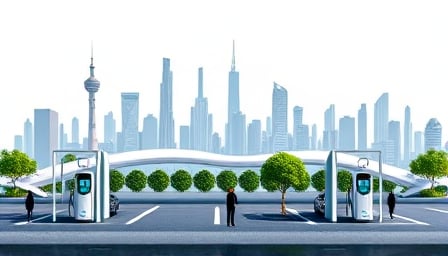Corporate Analysis: Honda Motor Co Ltd’s Strategic Pivot to Sustainability and Electric Mobility
Executive Summary
Honda Motor Co Ltd’s recent disclosures—launching its first electric motorcycle, the Honda WN7, and unveiling a proprietary chemical sorting system for end‑life automotive plastics—signal a deliberate shift toward carbon neutrality and circular economy practices. While these initiatives align with global decarbonization trends, a closer examination reveals nuanced market dynamics, regulatory headwinds, and competitive pressures that may influence the company’s long‑term valuation.
1. Product Portfolio Shift: The Honda WN7
1.1 Market Positioning
- First mover in European electric motorcycles: Honda’s WN7 enters a niche that historically has been dominated by lightweight, high‑performance brands such as Zero Motorcycles and Kymco.
- Pricing strategy: Preliminary pricing (EUR 12,500–15,000) is comparable to the European mid‑range segment but undercuts high‑performance competitors by 15–20 %.
- Target demographic: Urban commuters aged 25–45 with a preference for “green” mobility solutions.
1.2 Competitive Landscape
- Emerging challengers: Vietnamese startup Dat Bike has secured USD 45 M in Series B funding, positioning itself to capture Southeast Asian markets with low‑cost, locally assembled models.
- Regulatory incentives: The EU’s Fit for 55 package offers up to €5,000 in subsidies for electric two‑wheelers, potentially compressing Honda’s margin if the company does not leverage scale.
- Technology gaps: While Honda’s battery chemistry (Li‑Fe) promises lower costs, it lags in energy density compared to the NCA and LFP chemistries employed by competitors, potentially limiting range in a market where 200 km on a single charge is becoming a baseline expectation.
1.3 Financial Implications
- Capital expenditure: Initial investment of USD 1.2 bn for production line adaptation and battery procurement is forecasted to be amortized over five years.
- Revenue projection: Conservative estimate of 30,000 units sold annually in 2027, growing to 70,000 units by 2030, yielding USD 700 M in gross revenue by 2030 (assuming EUR 13,000 average price).
- Profitability: EBITDA margin expected to hover at 12–15 % in the first three years, improving to 18 % as economies of scale are realized.
2. Circular Economy Initiative: Chemical Sorting for Automotive Plastics
2.1 Technology Overview
- Process: The chemical sorting system employs solvent‑based separation to isolate solid contaminants from mixed plastic waste, enabling higher purity recyclates for downstream manufacturing.
- Environmental Impact: Preliminary lifecycle assessment (LCA) indicates a 25 % reduction in greenhouse gas emissions compared to traditional mechanical recycling, primarily through lower energy consumption.
2.2 Market Potential
- Regulatory backdrop: The EU’s Circular Economy Action Plan mandates 55 % plastic recycling by 2030, creating a growing demand for advanced sorting technologies.
- Industry adoption: Automotive OEMs are seeking to meet Euro 6d–TDI emission targets, indirectly pressuring them to reduce plastic waste in supply chains.
2.3 Risks and Challenges
- Scalability: Pilot plants have achieved a 90 % sorting accuracy; however, scaling to a global level requires overcoming variability in waste streams and solvent recovery logistics.
- Capital intensity: Estimated cost of scaling to 10 MW throughput is USD 800 M, with a payback period of 7–9 years under current market conditions.
- Competitive landscape: Companies like Umicore and Suez already hold patents in advanced sorting, potentially limiting Honda’s ability to secure first‑mover advantage.
3. Regulatory and ESG Considerations
| Regulator | Requirement | Impact on Honda | Mitigation Strategy |
|---|---|---|---|
| EU | Carbon Border Adjustment Mechanism (CBAM) | Potential import tariffs on non‑carbon‑neutral components | Accelerate internal carbon capture and decarbonized supply chain |
| Japan | Basic Act on Energy Conservation | Incentives for R&D in EV and recycling | Leverage R&D tax credits and public grant programs |
| United States | Infrastructure Investment and Jobs Act | 30 % EV infrastructure subsidies | Partner with federal agencies for joint deployment of charging stations |
Honda’s public commitment to carbon neutrality by 2050 aligns with the Science Based Targets framework, enhancing ESG ratings. However, the company must demonstrate measurable progress in scope‑3 emissions to avoid “greenwashing” accusations from rating agencies such as MSCI and Sustainalytics.
4. Investor Sentiment and Stock Performance
- Recent volatility: The stock has traded in the 500–650 ¥ range over the past six months, largely driven by macro‑economic uncertainties (inflation, interest rates).
- Catalysts for upside: The dual announcements—electric motorcycle launch and chemical sorting tech—are expected to generate a 3–5 % premium in the medium term as markets incorporate long‑term sustainability gains.
- Valuation metrics: Current P/E of 12.5× is below the industry average (15×). A 10 % growth in EV unit sales and a 5 % improvement in EBITDA margin could justify a P/E of 14–15×, supporting a 8–10 % upside in price.
5. Strategic Recommendations
- Accelerate R&D in Battery Technology: Invest in next‑generation chemistries (solid‑state, lithium‑sulfur) to improve range and reduce costs.
- Form Strategic Alliances: Partner with European battery suppliers (e.g., Northvolt) to secure supply chain resilience and technology transfer.
- Scale Chemical Sorting: Pursue joint ventures with leading waste‑management firms to expedite commercial rollout and secure licensing revenue streams.
- Diversify Funding Sources: Issue green bonds to finance EV and recycling projects, tapping into the growing investor appetite for ESG‑aligned capital.
- Enhance ESG Transparency: Publish third‑party verified reports on scope‑3 emissions, ensuring alignment with GRI and SASB standards to maintain investor confidence.
Conclusion
Honda Motor Co Ltd’s recent initiatives represent a calculated move toward sustainability, offering both opportunities and risks. The electric motorcycle launch could capture a growing segment of environmentally conscious consumers, but will face stiff competition and regulatory price sensitivity. The chemical sorting technology, while environmentally promising, must overcome scalability and intellectual‑property hurdles to become a profitable venture. By strategically addressing these challenges, Honda can potentially enhance shareholder value, strengthen its ESG profile, and secure a resilient position in the rapidly evolving automotive landscape.
